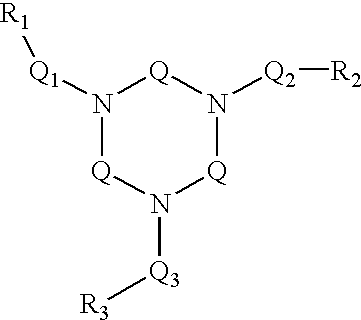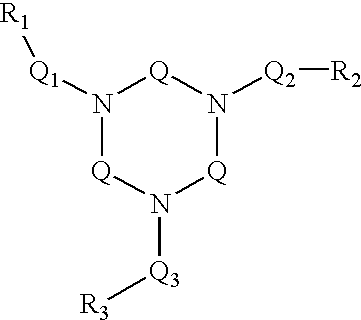Ligand and complex for catalytically bleaching a substrate
a technology of complexes and substrates, applied in the field of peroxygen bleaching, can solve the problems of high capital costs, premature damage to substrates, inefficient cleaning, etc., and achieve the effects of low dosage requirements, short contact times, and low cos
- Summary
- Abstract
- Description
- Claims
- Application Information
AI Technical Summary
Benefits of technology
Problems solved by technology
Method used
Image
Examples
Embodiment Construction
The following compound was prepared:
Compound 1: [FeL.sup.4 Cl] (ClO.sub.4).sub.2
L.sup.1 =1,4-bis(5-methyl-pyridin-2-ylmethyl)-7-ethyl-1,4,7-triazacyclononane
Synthesis of ligand L.sup.1 : 1,4-bis(5-Methyl-pyridyl-2-methyl)-7-ethyl-1,4,7-triazacyclononane
1,4,7-Triazacyclononane
Ligand 1,4,7-triazacyclononane was produced according the modified method used by the team of Prof. Wieghardt. In this method the detosylation of the 1,4,7-tris-p-toluenesulfon-1,4,7-triazacylononanamide is performed in 5 minutes in hot sulphuric acid of 180.degree. C. Once the solution has cooled down it is transferred into ether under vigorous stirring. The solution that surfaces is decanted and the residue is dissolved in some boiling water. At boiling temperature drops of concentrated hydrochloric acid are added. The brown crystals that precipitate are drained off and washed with cold hydrochloric acid and then with ethanol and ether. The 1,4,7-triazacyclononane. trihydrochloride thus produced is then proces...
PUM
| Property | Measurement | Unit |
|---|---|---|
| temperatures | aaaaa | aaaaa |
| pH | aaaaa | aaaaa |
| pH | aaaaa | aaaaa |
Abstract
Description
Claims
Application Information
 Login to View More
Login to View More - R&D
- Intellectual Property
- Life Sciences
- Materials
- Tech Scout
- Unparalleled Data Quality
- Higher Quality Content
- 60% Fewer Hallucinations
Browse by: Latest US Patents, China's latest patents, Technical Efficacy Thesaurus, Application Domain, Technology Topic, Popular Technical Reports.
© 2025 PatSnap. All rights reserved.Legal|Privacy policy|Modern Slavery Act Transparency Statement|Sitemap|About US| Contact US: help@patsnap.com



